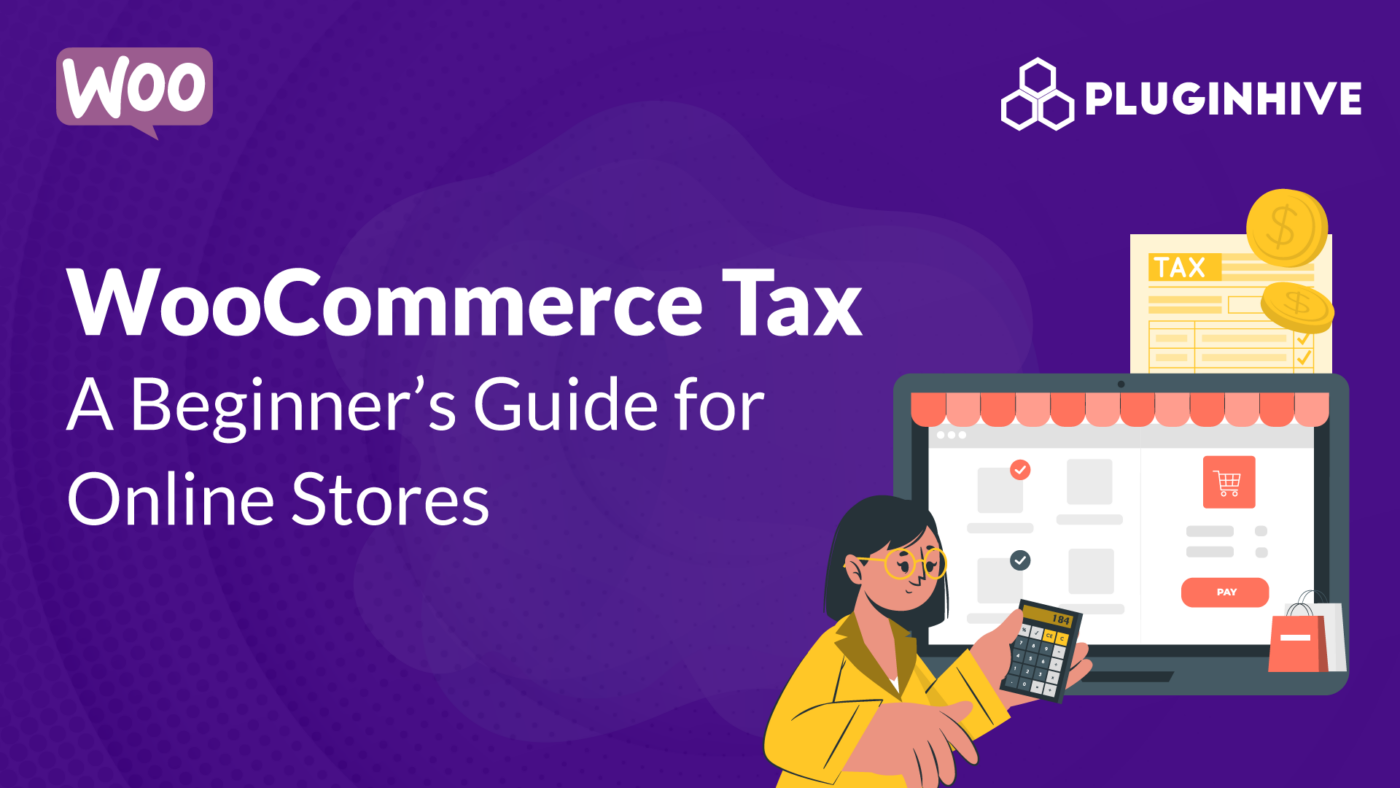Understanding taxes is vital for any WooCommerce business owner. Managing taxes properly within WooCommerce isn’t just about following rules; it’s crucial for gaining customer trust and ensuring smooth transactions. In this guide, we’ll focus on WooCommerce tax, explaining its importance, providing a step-by-step setup guide, and highlighting key compliance factors to simplify tax management.
Whether you’re new to e-commerce or a seasoned seller, mastering WooCommerce tax is essential for running your business smoothly and staying on the right side of the law.
On this page
- Importance of WooCommerce Tax Compliance
- Setting Up Tax in WooCommerce
- 4 Things to Keep in Mind for WooCommerce Tax Setup
Importance of WooCommerce Tax Compliance
In e-commerce, adhering to tax regulations is paramount, especially within WooCommerce. Compliance with WooCommerce tax rules ensures precise tax calculations, guaranteeing accurate tax application with every sale. Failing to meet these standards might lead to penalties, audits, and legal repercussions, affecting your store’s stability and reputation within the WooCommerce ecosystem.
Legal Implications of Correct Tax Configuration
Within WooCommerce, overlooking or mismanaging tax setup could result in severe legal consequences. Inaccurate tax reporting might attract fines, audits, or legal actions, disrupting your operations and adding unforeseen expenses. Properly configuring taxes in WooCommerce safeguards your business, ensuring legal adherence and contributing to long-term credibility and growth.
Building Customer Trust through Optimal Tax Management
Transparent and accurate tax handling in WooCommerce significantly impacts customer trust. When your online store displays prices inclusive of precise taxes and executes transactions seamlessly, it elevates the shopping experience. Such transparency instills confidence in customers, fostering satisfaction, loyalty, and positive feedback, vital for sustained success in WooCommerce.
Setting Up Tax in WooCommerce
Setting up taxes within WooCommerce is essential for legal compliance and seamless transactions. Let us check out the key steps from basic configurations to defining tax zones, assigning product tax classes, and selecting suitable calculation methods. By following these instructions, you’ll ensure accurate tax application, comply with regulations, and provide transparent pricing for your customers.
- Log in to your WordPress dashboard, navigate to WooCommerce, and select “Settings“.
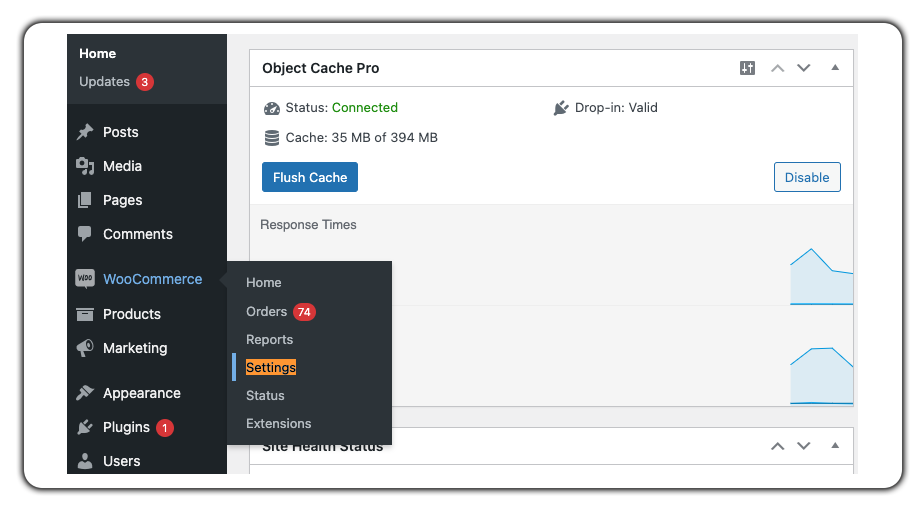
- Under the WooCommerce General Settings enable “Enable taxes.”
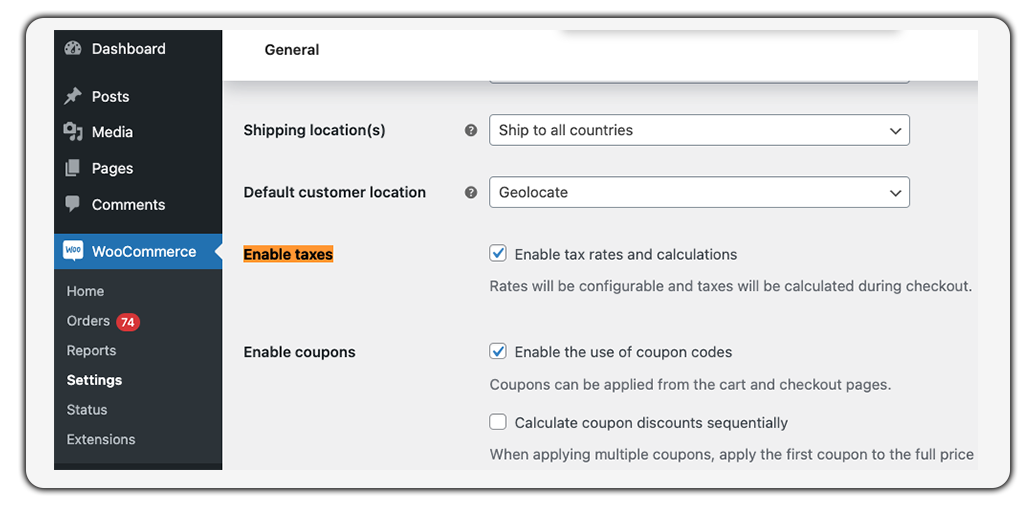
Basic Tax Settings
Most of the WooCommerce tax settings are located in the Tax Options section.
When entering prices, you have the choice to include or exclude tax:
- “Yes, I will enter price inclusive of tax“: Newly created products will include tax based on the defined rate.
- “No, I will enter prices exclusive of tax“: Newly created products won’t include tax, but during checkout, prices will increase by the defined tax rate.
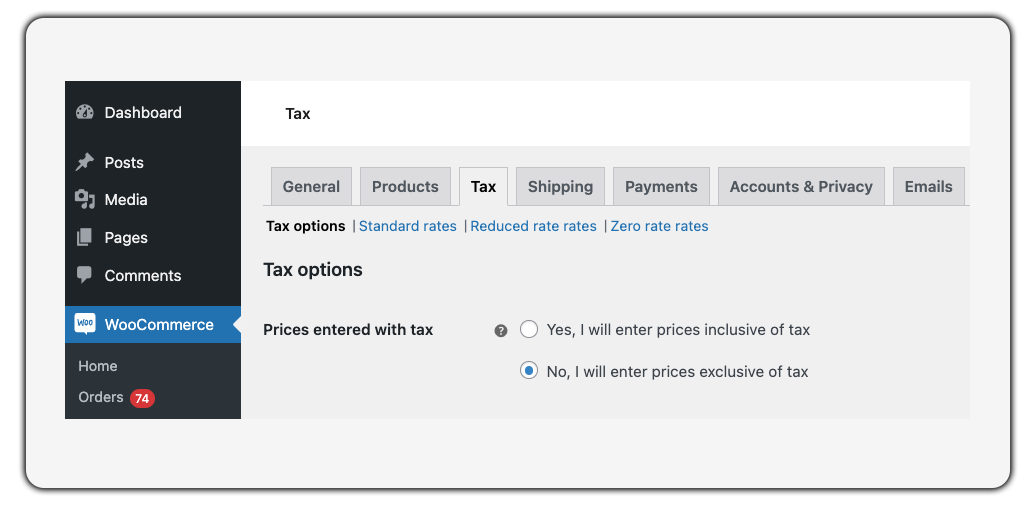
Note: Changing this setting won’t affect existing products.
For tax calculations based on addresses, select:
- “Customer shipping address“: Modify the default customer address in General Settings.
- “Customer billing address.“
- “Shop address“: Taxes will always be calculated based on the shop’s location, not the customer’s.
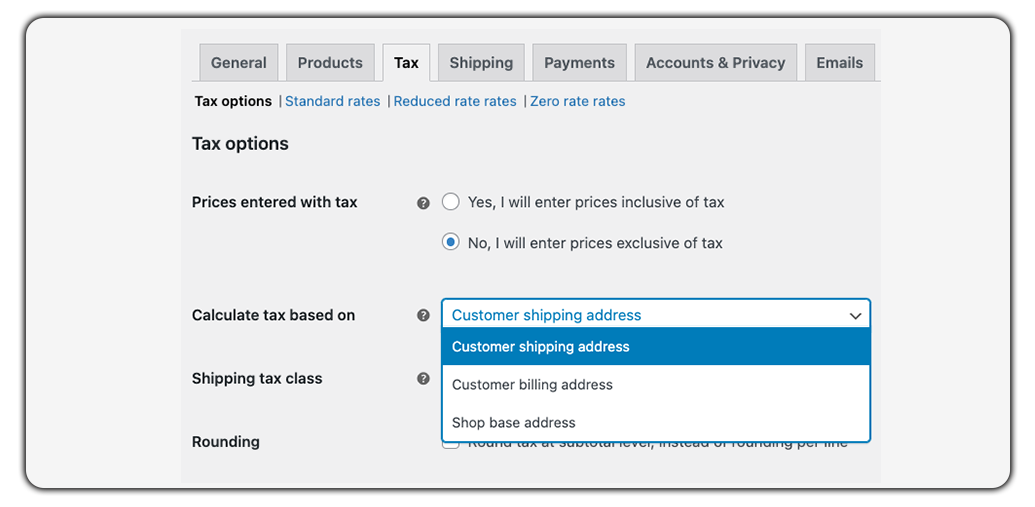
Shipping Tax Class Settings
- By default, the tax class is applied based on products in the cart. If various products with different tax rates are in the cart, the highest rate will apply to shipping.
- Set a custom rate for shipping costs, which will always be applied to shipping.
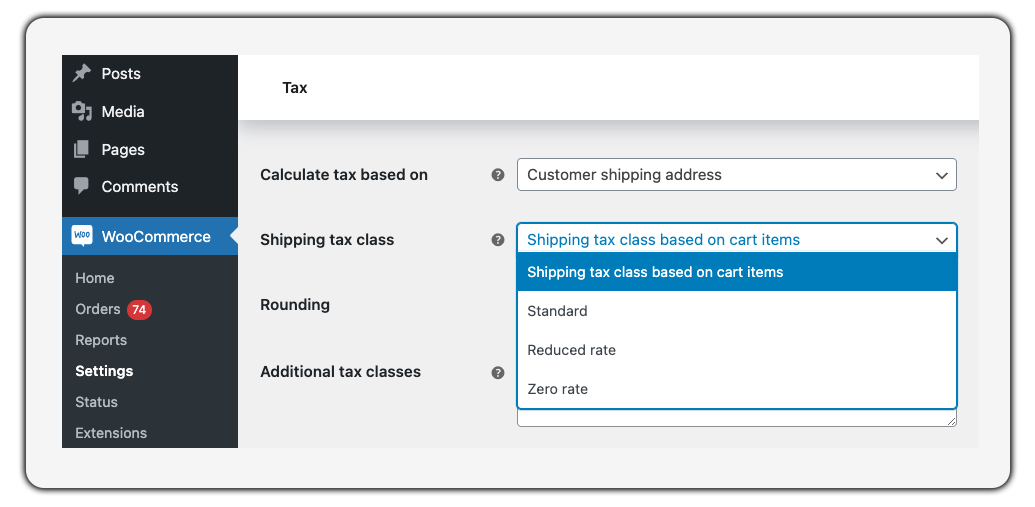
- Tick the “Rounding” option for subtotal-level tax rounding.
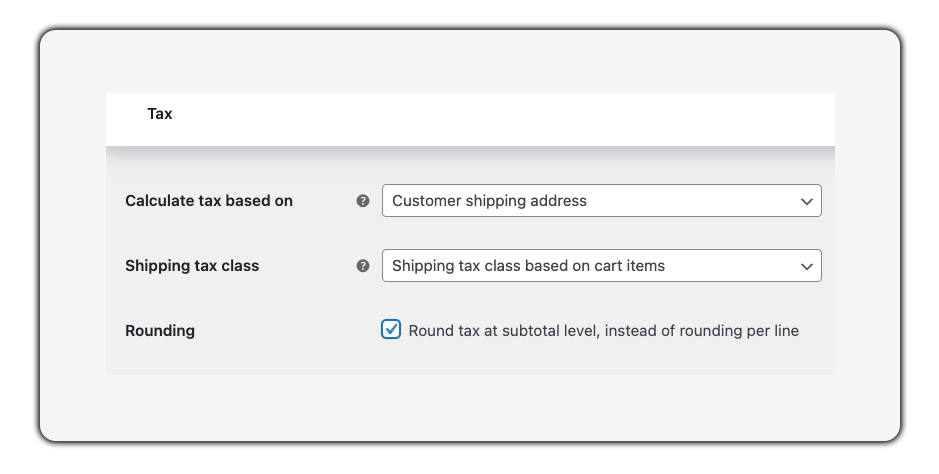
- Display prices in the shop: Choose between displaying prices that already include tax or those without tax included.
- Display prices during cart and checkout: Determine whether prices shown in the cart and during checkout should include tax or remain exclusive of tax.
- Price display suffix: Specify the text to accompany prices. If you display prices including tax, opt for the suffix “inc. VAT” or “gross.”
- Display tax totals: Decide if taxes should be presented as a total sum or broken down by specific tax rates.
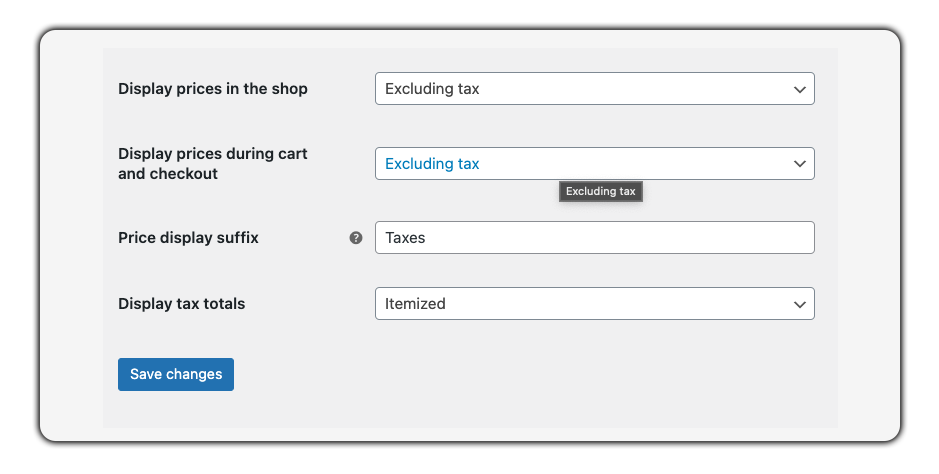
Woocommerce Standard Tax Rates Configuration
By default, you can set up standard tax rates under the Standard rates category. To add a new rate, simply click on “Insert row” and enter the following:
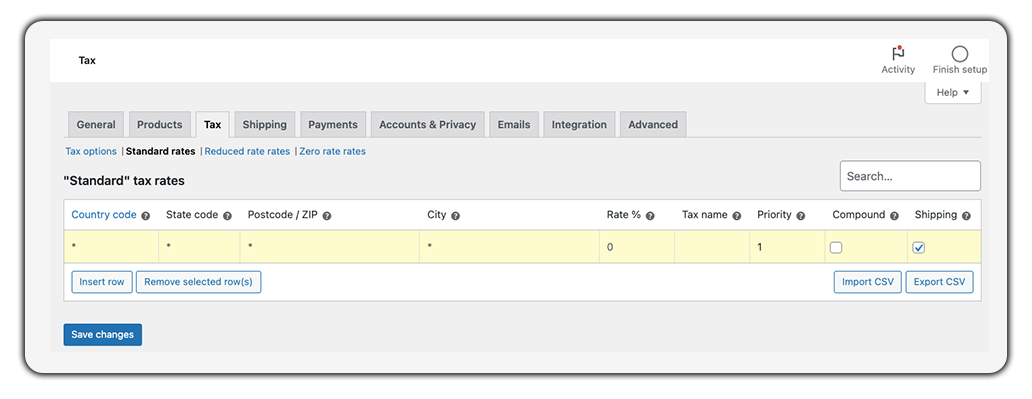
- Country Code: Input a two-letter country code based on ISO 3166-1 alpha-2 standards. If left empty, this rate applies universally across all countries.
- State Code: Similar to the country code, use a two-letter code or leave this field empty for application across all states. This field is relevant for specific countries only.
- ZIP/Postcode: Enter one or multiple postcodes, separated by a semi-colon. Specify a range using a dash between border values. Leave blank for universal application.
- City: Specify the city or multiple cities where this tax rate should be applied. Separate multiple cities with a semi-colon or leave blank for universal application.
- Rate %: Define the tax rate value in percent format, with up to four decimal places. Exclude the “%” symbol. For example, input “20” for a 20% tax rate. Use decimal numbers only if the rate isn’t a whole number, e.g., “18.5”.
- Tax Name: Enter a name for the tax. This name appears for customers in your shop and on WooCommerce invoices. For instance, “VAT 20%”.
- Priority: Set a priority for different tax rates to determine their order of application. Ensure unique priorities for each rate to display all applicable rates in a WooCommerce invoice.
- Compound: Check this field if it’s a compound rate. A compound tax is applied after the calculation of other rates, implying that this tax applies to the already taxed product.
Testing and Validation
Before making your store live, test the tax setup by creating sample orders and checking if taxes apply correctly. Also, make sure to vValidate tax calculations for different products and geographic locations.
By following these step-by-step instructions, you can effectively set up and manage taxes within your WooCommerce store, ensuring compliance with tax regulations and providing transparent pricing for your customers.
4 Things to Keep in Mind for WooCommerce Tax Setup
When configuring tax settings within WooCommerce, several critical factors demand attention. Understanding local tax laws, managing international taxes, staying updated with evolving regulations, and rigorous testing all play pivotal roles. These considerations ensure accurate tax application, legal compliance, and a seamless shopping experience for your customers within the WooCommerce platform.
1. Adherence to Local Tax Laws within WooCommerce
Within WooCommerce, aligning with local tax laws is crucial. Understanding and complying with regional tax regulations ensures your store operates legally and avoids potential penalties. Configuring WooCommerce tax settings according to specific locality guidelines creates a solid foundation for sustainable business operations within diverse geographical markets.
2. Handling International Taxes in WooCommerce
Expanding into international markets via WooCommerce requires careful consideration of cross-border taxes. Managing taxes across different countries involves complexities. Utilizing WooCommerce’s features to configure taxes for international sales ensures compliance with varying tax rates, tariffs, and cross-border tax regulations, enabling smooth cross-border transactions.
3. Regular Updates for Tax Settings in WooCommerce
WooCommerce evolves, and so do tax laws. It’s imperative to regularly update tax settings in response to changes in regulations or tax rates. By staying abreast of these adjustments and promptly updating your WooCommerce tax configurations, you maintain compliance, avoid potential legal issues, and ensure accurate tax calculations for your customers.
4. Testing and Validating WooCommerce Tax Setups
Before implementing tax settings live, thorough testing is essential. Validating tax setups within WooCommerce guarantees accuracy and functionality. Testing enables you to identify and rectify any discrepancies, ensuring that your tax calculations align correctly with your pricing structures, and providing a seamless shopping experience for your customers.
Conclusion
In the dynamic landscape of e-commerce, mastering WooCommerce tax setup is pivotal for legal compliance and customer satisfaction. This comprehensive guide has navigated through the intricate process, from configuring basic settings to defining tax, assigning classes, and selecting calculation methods. Understanding local laws, updating tax settings, and meticulous testing are essential for seamless operations within WooCommerce. Accurate tax application not only ensures legal adherence but also fosters customer trust through transparent pricing and a smoother shopping experience.
By leveraging the diverse settings and options provided by WooCommerce, businesses can maintain compliance, facilitate international trade, and adapt to evolving tax regulations. With diligence in tax management, businesses can forge ahead confidently, fostering growth, customer loyalty, and sustained success within the e-commerce sphere. Embracing the intricacies of WooCommerce tax setup empowers businesses to thrive in the competitive digital marketplace.

